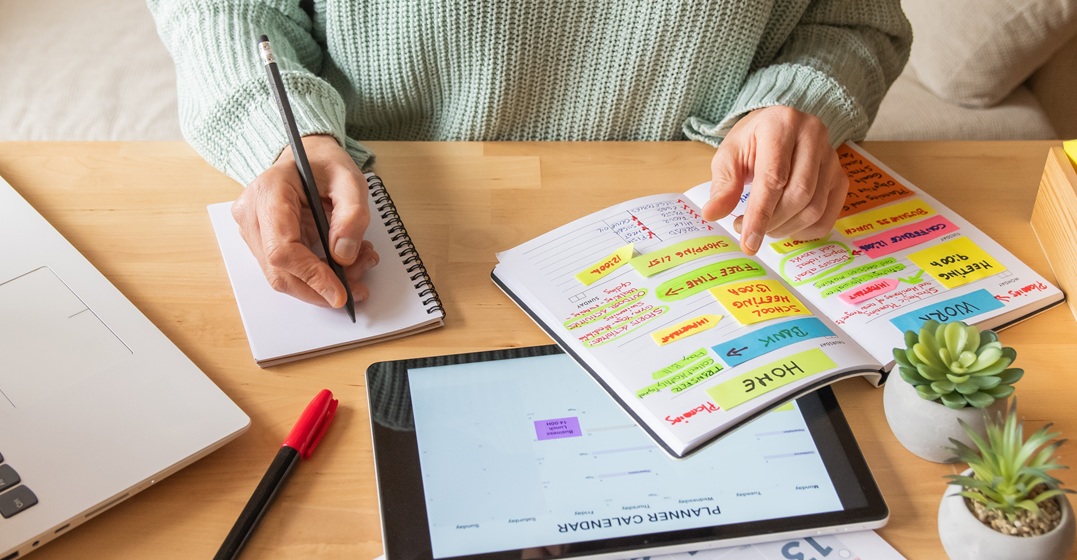Expressing time in French

Learning a new language can be daunting, and French is certainly no walk in the park. Expressing time in French is a vital part of speaking the language, and it can help you in your everyday life – especially if you have a jam-packed schedule when visiting (or living) in France.
This article covers the basics of how to learn time in French, important lessons on time to know about and French clock times.
- What are the basics for telling the time in French?
- What important points do I need to know about?
- How do I express time in French?
- Common expressions for telling time in French
- Vocabulary and expressions related to dates
Learn languages at your pace
What are the basics for telling the time in French?
First off, it’s important to know your numbers in French before you start learning about time. You’ll only need to know numbers 1-59 and basic French grammar for expressing time in French and it’s worth using some vocabulary apps to help you practice.
In a French-speaking country, when asking for the time, you use the word "l'heure," not "le temps." The latter denotes time in the sense of duration, as in "I spent a lot of time there."
Unlike English, where "o'clock" is often omitted ("It's seven" or "I'm leaving at three-thirty" are acceptable), in French, you always include "heure," except when referring to noon ("midi") and midnight ("Il est minuit").
When expressing time in French, the hour and minute are separated by "h" (for "heure"), as in "2h00," whereas in English, we use a colon (":"), as in "2:00."
Nevertheless, time is typically conveyed using a 24-hour clock. Thus, 3 p.m. is commonly expressed as "quinze heures" (15 hours) or "15h00." Yet, you can also say "trois heures de l'après-midi" (three hours after noon).
What important points do I need to know about?
There are a few important points you should know about when it comes to expressing time in French, especially the difference between morning and afternoon hours:
- First, in French, it is quite common to use the 24-hour clock to express time, rather than the 12-hour clock. For example, 5 o’clock in the afternoon would be expressed as 17:00, rather than 5:00.
- AM and PM do not exist in French, therefore to express this in French you can say du matin (in the morning), de l’après-midi (in the afternoon) and du soir (in the evening). Otherwise, you can just use the French clock times, i.e. expressing time using the 24-hour clock.
- There are three ways of writing “time” in French, but for expressing time, we’ll only use the first term:
- L’heure - this is used to express time in French
- Le temps - time in the context of a period of time, for example: J’ai passé beaucoup de temps avec ma famille (I spent a lot of time with my family).
- La fois - time in the context of one instance, for example: Je suis allé.e au cinéma deux fois (I went to the cinema twice).
- When expressing times like “ten to five” or “twenty to two”, the French say “five o’clock minus ten” and “two o’clock minus twenty” (we’ll cover this in detail down below).
How do I express time in French?
Now let’s get down to the nitty-gritty of expressing time in French.
Asking what the time is
If you want to ask what time it is in French, you can say:
Quelle heure est-il ? or Il est quelle heure ? (What time is it?)
The first phrase is more formal while the second phrase is more common and informal, so you can use it when asking a family member or a friend.
Avez-vous l’heure, s'il vous plaît ? (Do you have the time, please?)
This is another formal way of asking for the time.
If you want to learn how to be polite in French, you should also learn how to say "please" and "excuse me" when talking to strangers.
À quelle heure….? (At what time…?)
This phrase is very useful when you want to ask the time for a specific event, like a concert:
À quelle heure commence le concert ? (What time does the concert start?)
Replying to the question
The most common phrase to express time in French is:
Il est heure(s) (It’s o’clock)
Here are some examples:
Il est une heure (It’s one o’clock)
Il est quinze heures (It’s 3 pm)
Il est trois heures de l’après-midi (It’s 3 o’clock in the afternoon)
*Note the use of heure in the plural form (heures) when we are using any numbers from two and above.
A table for expressing time in French
Here’s a table to help you learn how to express and write time in French. Each row includes several ways to express the given time.
| English | French |
| Midday | Midi / 12 h |
| Midnight | Minuit / 00 h |
| 2 o’clock in the afternoon 2pm | Il est deux heures de l’après-midi Il est quatorze heures / 14 h |
| 3:15am 3:15pm 3:15pm | Il est trois heures quinze / 3 h 15 Il est quinze heures quinze Il est quinze heures et quart / 15 h 15 |
| 4:30am4:30pm4:30am | Il est quatre heures trente / 4 h 30 Il est seize heures trente Il est quatre heures trente du matin |
| 6:45pm | Il est dix-huit heures quarante-cinq / 18 h 45 Il est six heures quarante-cinq du soir Il est sept heures moins quart |
| 22:50 | Il est vingt-deux heures cinquante / 22 h 50 Il est onze heures moins dix (it’s “eleven o’clock minus ten” = ten to eleven) |
This video also goes over these expressions and is a great way to practice your pronunciation:
Common expressions for telling time in French
The usual phrases used for telling time are similar in French and English. Expressions like "quarter to" or "quarter past" are common in French too. The terms "moins" (meaning "minus") and "et" (meaning "and") are used in this context. Here are a few examples:
- "It's a quarter to five" translates to "il est cinq heures moins le quart" (literally: "It is five hours minus quarter").
- "Quarter past one" is expressed as "Une heure et quart." (literally: "It is one hour and a quarter").
"Moins" is used to indicate "minutes before" an hour. For instance, "it's ten to eleven" translates to "il est onze heures moins dix" (literally: "It is eleven hours minus ten").
"Et" is used when indicating "quarter past" or "half past." When stating the specific number of minutes, "et" is not necessary. "Half past" is expressed by adding "et demie" to the end of the time phrase. For example, "Neuf heures et demie" means "half past nine."
"Midi" refers to midday or noon. For instance, "Il est midi" means "It's midday."
"Minuit" means midnight. For example, "Il est minuit" translates to "It's midnight."
Learn languages at your pace
Vocabulary and expressions related to dates
Expanding your proficiency in telling time also involves mastering related vocabulary and expressions. Here are some essential words and phrases:
- Souvent? - How often?
- Tous les jours - Every day
- Tous les deux jours - Every other day
- Une fois par semaine - Once a week
- Deux fois par semaine - Twice a week
- Une fois par mois - Once a month
- Ça s'est passé quand ? - When did it happen?
- Hier - Yesterday
- Hier soir - Yesterday evening
- Avant-hier - The day before yesterday
- Il y a une semaine - A week ago
- Il y a quinze jours - Two weeks ago
- L'an dernier or l'année dernière - Last year
- Ça va se passer quand ? - When is it going to happen?
- Demain - Tomorrow
- Demain matin - Tomorrow morning
- Après-demain - The day after tomorrow
- Dans deux jours - In two days
- Dans une semaine - In a week
- Dans quinze jours - In two weeks
- Le mois prochain - Next month
- L'an prochain or l'année prochaine - Next year
Spare time
So there you have it: A summary of how to learn time in French, including the specific points to keep an eye out for and ways to express time in the language.
If you have some spare time, it’s worth going over this as it’s a fundamental part of everyday life. You can also take a look at other French resources to help you continue to learn time and other important elements of this beautiful language.
FAQs
In this section, you'll also find the most frequently asked questions about telling time in the French language
How do you say 8:45 in French?
In French, you say "Il est huit heures quarante-cinq" for 8:45.
How do you say 10:30 in French?
In French, 10:30 is pronounced as "dix heures trente"2" (ten thirty) or "dix heures et demie" (a half past ten).
Do the French use a 24-hour clock?
Yes, the French commonly use the 24-hour clock format, also known as military time in the United States.
How do you read a French clock?
To read a French clock, simply state the hour followed by "heures" and then the minutes. You can add du matin (in the morning), de l’après-midi (in the afternoon) and du soir (in the evening), if you need to specify.
How do you write time in French format?
Time in French format typically follows the pattern of stating the hour, followed by "h" for "heure," and then the minutes. For example, 3:30 p.m. would be written as "15h30."
Summing up: Expressing time in French
For French learners, mastering the art of telling time is essential. Understanding French numbers and expressions is fundamental, especially when talking to people in French-speaking countries.
This article has covered the basics of telling time in French, from the use of the 24-hour clock to nuanced expressions like "moins" and "et." Learning to differentiate between "l'heure," "le temps," and "la fois" enhances comprehension.
Additionally, familiarizing oneself with vocabulary related to dates broadens language proficiency. By practicing pronunciation and incorporating these concepts, French learners can confidently navigate time-related conversations.
Whether scheduling appointments or engaging in casual discussions, the best time to learn the French language is always now!













